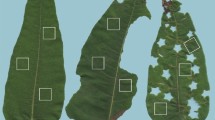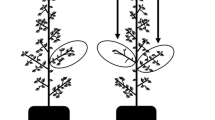Abstract
Studies on induced defenses have predominantly focused on foliar induction by above-ground herbivores and pathogens. However, roots are attacked by as many if not more phytophages than shoots, so in reality plants are exposed to above- and below-ground attack. Here, we report effects of foliar and/or root damage on terpenoid aldehyde accumulation in cotton (Gossypium herbaceum). Using HPLC, we analyzed concentrations of individual terpenoid aldehydes in foliage and root tissue. In undamaged plants, terpenoid aldehydes were concentrated in young immature main leaves. Concentrations in side leaves, branching from the main leaves, did not differ among leaf position. Above-ground feeding by Spodoptera exigua larvae on a mature leaf enhanced terpenoid concentrations in immature leaves but not in the damaged leaf. In particular, concentrations of hemigossypolone and the heliocides 1 and 4 were enhanced following herbivory. Root herbivory by wireworms (Agriotes lineatus) also resulted in an increase in terpenoid levels in the foliage. In contrast with foliar herbivory, both immature and mature leaves were induced. However, the level of induction after root herbivory was much lower compared to foliar herbivory. Plants exposed to root herbivory also had significantly higher levels of terpenoid aldehydes in root tissue, while no such effect was found following foliar herbivory. Plants exposed to both root and foliar herbivory appeared to induce primarily above-ground at the cost of below-ground defense. The implications for above- and below-ground Mutitrophic interactions are discussed.
Similar content being viewed by others
References
Anderson,P. and Alborn,H. 1999. Effects on oviposition behaviour and larval development of Spodoptera littoralis by herbivore-induced changes in cotton plants. Entomol. Exp. Appl. 92:45-51.
Bell,A. A., Stipanovic,R. D., O'brien,D. H., and Fryxell,P. A. 1978. Sesquiterpenoid aldehyde quinones and derivatives in pigment glands of Gossypium. Phytochemistry 77:1297-1305.
Bezemer,T. M., Knight,K. J., Newington,J. E., and Jones,T. H. 1999. How general are aphid responses to elevated atmospheric CO2? Ann. Entomol. Soc. Am. 95:724-730.
Bezemer,T. M., Wagenaar,R., Van Dam,N. M., and Wäckers,F. L. 2003. Interactions between above-and belowground insect herbivores as mediated by the plant defense system. Oikos 101:555-562.
Brown,V. K. and Gange,A. C. 1990. Insect herbivory below ground. Adv. Ecol. Res. 20:1-58.
de Deyn,G. B., Raaijmakers,C. E., Zoomer,H. R., Berg,M. P., De Ruiter,P. C., Verhoef,H. A., Bezemer,T. M., and Van Der Putten,W. H. 2003. Soil invertebrate fauna enhances grassland succession and diversity. Nature 422:711-713.
Edwards,P. J. and Wratten,S. D. 1983. Wound induced defences in plants and their consequences for patterns of insect grazing. Oecologia 59:88-93.
Hanounik,S. B. and Osborne,W. W. 1977. The relationships between population density of Meloidogyne incognita and nicotine content of tobacco. Nematologica 23:147-152.
Hartley,S. E. and Jones,C. G. 1997. Plant chemistry and herbivory: Or why the world is green, pp. 284-324, in M. J. Crawley (ed.). Plant Ecology,2nd edn. Blackwell Science, Oxford, UK.
Hedin,P. A., Parrott,W. L., and Jenkins,J. N. 1992. Relationships of glands, cotton square terpenoid aldehydes, and other allelochemicals to larval growth of Heliothis virescens doptera, Noctuidae. J. Econ. Entomol. 85:359-364.
Howell,C. R., Hanson,L. E., Stipanovic,R. D., and Puckhaber,L. S. 2000. Induction of terpenoid synthesis in cotton roots and control of Rhizoctonia solani by seed treatment with Trichoderma virens. Phytopathology 90:248-252.
Jones,C. G., Hopper,R. F., Coleman,J. S., and Krischik,V. A. 1993. Control of systemically induced herbivore resistance by plant vascular architecture. Oecologia 93:452-456.
Karban,R. and Baldwin,I. T. 1997. Induced Responses to Herbivory. University of Chicago Press, Chicago.
Khan,M. A., Stewart,J. M., and Murphy,J. B. 1999. Evaluation of the Gossypium gene pool for foliar terpenoid aldehydes. Crop Sci. 39:253-258.
Khoshkhoo,N., Hedin,P. A., and Mccarty,J. C. 1993. Effects of bioregulators on the terpenoid aldehydes in root-knot nematode infected cotton plants. J. Agric. Food Chem. 41:2442-2446.
Krischik,V. A. and Denno,R. F. 1983. Individual, population and geographical patterns in plant defense, pp. 463-512, in R. F. Denno, and M. S. Mcclure (eds.) Variable Plants and Herbivores in Natural and Managed Systems. Academic Press, New York.
Liu,J. G., Benedict,C. R., Stipanovic,R. D., and Bell,A. A. 1999. Purification and characterization of S-adenosyl-L-methionine: Desoxyhemigossypol-6-O-methyltransferase from cotton plants. An enzyme capable of methylating the defense terpenoids of cotton. Plant Physiol. 121:1017-1024.
Mace,M. E., Stipanovic,R. D., and Bell,A. A. 1990. Relation between sensitivity to terpenoid phytoalexins and virulence to cotton of Verticillium dahliae strains. Pestic. Biochem. Physiol. 36:79-82.
Mcauslane,H. J. and Alborn,H. T. 1998. Systemic induction of allelochemicals in glanded and glandless isogenic cotton by Spodoptera exigua feeding. J. Chem. Ecol. 24:399-416.
Mcauslane,H. J., Alborn,H. T., and Toth,J. P. 1997. Systemic induction of terpenoid aldehydes in cotton pigment glands by feeding of larval Spodoptera exigua. J. Chem. Ecol. 23:2861-2879.
Ohnmeiss,T. E. and Baldwin,I. T. 2000. Optimal defense theory predicts the ontogeny of an induced nicotine defense. Ecology 81:1765-1783.
Röse,U. S. R., Lewis,W. J., and Tumlinson,J. H. 1998. Specificity of systemically released cotton volatiles as attractants for specialist and generalist parasitic wasps. J. Chem. Ecol. 24:303-319.
Rudgers,J. A. 2003. Behavioral mechanisms underlie an ant–plant mutualism. Oecologia 135:51-59.
Stipanovic,R. D., Altman,D. W., Begin,D. L., Greenblatt,G. A., and Benedict,J. H. 1988. Terpenoid aldehydes in upland cotton: Analysis by aniline and HPLC methods. J. Agric. Food Chem. 36:509-515.
Stipanovic,R. D., Bell,A. A., and Lukefahr,M. J. 1977. Natural insecticides from cotton (Gossypium), pp. 197-214, in P. A. Hedin (ed.) Host Plant Resistance to Insect Pests. Symposium Series 62. American Chemical Society, Washington, DC.
Stipanovic,R. D., Bell,A. A., O'brien,D. H., and Lukefahr,M. J. 1978a. Heliocide H1: A new insecticidal C25 terpenoid from cotton (Gossypium hirsutum). J. Agric. Food Chem. 26:115-118.
Stipanovic,R. D., Bell,A. A., O'brien,D. H., and Lukefahr,M. J. 1978b. Heliocide H3 an insecticidal terpenoid from Gossypium hirsutum. Phytochemistry 17:151-152
Stipanovic,R. D., Ellisalde,M. H., Altman,D. W., and Norman,J. O. 1990. Cell culture bioassay to evaluate allelochemical toxicity to Heliothis virescens. J. Econ. Entomol. 83:737-741.
Stout,M. J., Workman,K. V., and Duffey,S. S. 1996. Identity, spatial distribution, and variability of induced chemical responses in tomato plants. Entomol. Exp. Appl. 79:255-271.
Van Dam,N. M., De Jong,T. J., Iwasa,Y., and Kubo,T. 1996. Optimal distribution of defences: Are plants smart investors? Funct. Ecol. 10:128-136.
Van Dam,N. M., Harvey,J. A., Wäckers,F. L., Bezemer,T. M., Van Der Putten,W. H., and Vet,L. E. M. 2003. Interactions between aboveground and belowground induced responses against phytophages. Basic Appl. Ecol. 4:63-77.
Van Der Putten,W. H. 2003. Plant defense belowground and spatiotemporal processes in natural vegetation. Ecology 84:2269-2280.
Van Der Putten,W. H., Vet,L. E. M., Harvey,J. A., and Wäckers,F. L. 2001. Linking above-and belowground multitrophic interactions of plants, herbivores, pathogens, and their antagonists. Trends Ecol. Evol. 16:547-554.
Wäckers,F. L. and Bezemer,T. M. 2003. Root herbivory induces an above-ground indirect defence. Ecol. Lett. 6:9-12.
Wäckers,F. L., Zuber,D., Wunderlin,R., and Keller,F. 2001. The effect of herbivory on temporal and spatial dynamics of foliar nectar production in cotton and castor. Ann. Bot. 87:365-370.
Zangerl,A. R. and Bazzaz,F. A. 1992. Theory and pattern in plant defense allocation, pp. 363-391, in R. Fritz, and E. L. Simms, (eds.) Plant Resistance to Herbivores and Pathogens. University of Chicago Press, Chicago.
Zangerl,A. R. and Rutledge,C. E. 1996. The probability of attack and patterns of constitutive and induced defense: A test of optimal defense theory. Am. Nat. 147:599-608.
Zhang,J. X., Mace,M. E., Stipanovic,R. D., and Bell,A. A. 1993. Production and fungitoxicity of the terpenoid phytoalexins in cotton inoculated with Fusarium oxysporum f. sp. vasinfectum. J. Phytopathol. 139:247-252.
Author information
Authors and Affiliations
Rights and permissions
About this article
Cite this article
Bezemer, T.M., Wagenaar, R., van Dam, N.M. et al. Above- and Below-Ground Terpenoid Aldehyde Induction in Cotton, Gossypium herbaceum, Following Root and Leaf Injury. J Chem Ecol 30, 53–67 (2004). https://doi.org/10.1023/B:JOEC.0000013182.50662.2a
Issue Date:
DOI: https://doi.org/10.1023/B:JOEC.0000013182.50662.2a




